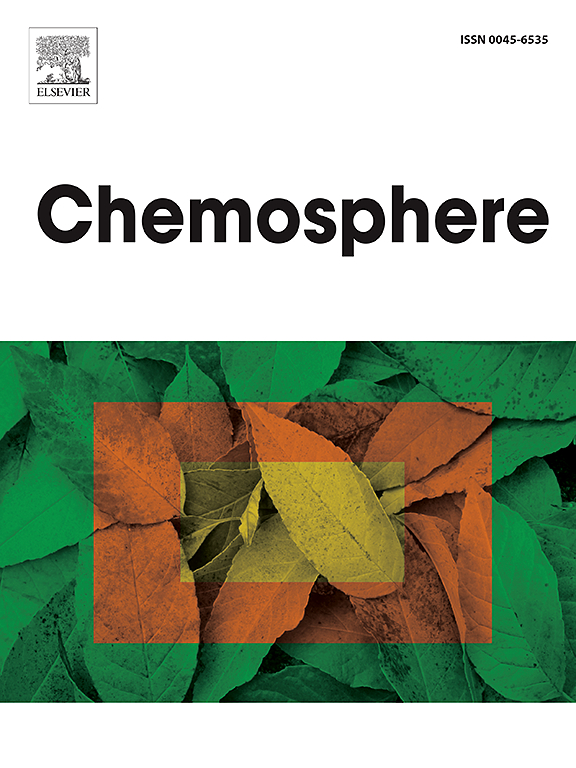Effects of perfluorooctanoic acid and nano titanium dioxide on the immune response and energy allocation in Mytilus coruscus
IF 8.1
2区 环境科学与生态学
Q1 ENVIRONMENTAL SCIENCES
引用次数: 0
Abstract
Perfluorooctanoic acid (PFOA) functions as a surfactant, while nano-titanium dioxide (nano-TiO2) serves as an antibacterial agent. These substances are extensively utilized in industrial production and, upon release into aquatic environments, pose significant threats to the viability and development of marine organisms. However, research into the effects of PFOA and nano-TiO2 on the immune functions and cellular energy allocation (CEA) of bivalves remains limited. To investigate the impact of PFOA and nano-TiO2 on immunity and cellular energy, we exposed Mytilus coruscus individuals to different concentrations of PFOA (2 and 200 μg/L), either alone or in combination with nano-TiO2 (0.1 mg/L, particle size: 25 nm) for 14 days. We found that the co-exposure to PFOA and nano-TiO2 had significant interactive effects on multiple immune function parameters of mussels. PFOA and nano-TiO2 notably reduced the total hemocyte count (THC), esterase activity (EST), mitochondrial number (MN), lysosomal content (LYSO), and cell viability, while concurrently elevating hemocyte mortality (HM) and reactive oxygen species (ROS) levels. Some immune-related genes, such as Tumor Necrosis Factor-alpha (TNF-α) and Myeloid Differentiation Primary Response 88 (MyD88) were downregulated, while others such as Interleukin 17 (IL-17) and Transforming Growth Factor-beta (TGF-β) were upregulated after 14-day exposure to combined pollutant exposure. Furthermore, negative effects on CEA were observed under both individual and combined pollutant stress. Therefore, PFOA and nano-TiO2 regulate cellular and humoral immunity through the regulation of immune genes as mediators, while simultaneously disrupting cellular energy metabolism. The immunotoxicity of organic and particulate pollutants, and their mixtures, thus poses a significant risk to the immune defense capabilities of mussel populations in polluted coastal environments.

全氟辛酸和纳米二氧化钛对珊瑚贻贝免疫反应和能量分配的影响
全氟辛酸(PFOA)作为表面活性剂,而纳米二氧化钛(纳米tio2)作为抗菌剂。这些物质广泛用于工业生产,一旦释放到水生环境中,对海洋生物的生存和发育构成重大威胁。然而,关于PFOA和纳米tio2对双壳类动物免疫功能和细胞能量分配(CEA)影响的研究仍然有限。为了研究PFOA和纳米tio2对贻贝个体免疫和细胞能量的影响,我们将不同浓度的PFOA(2和200 μg/L)单独或与纳米tio2 (0.1 mg/L,粒径:25 nm)联合暴露于贻贝个体14天。我们发现PFOA和纳米tio2共同暴露对贻贝的多种免疫功能参数有显著的交互作用。PFOA和纳米tio2显著降低了总血细胞计数(THC)、酯酶活性(EST)、线粒体数量(MN)、溶酶体含量(LYSO)和细胞活力,同时提高了血细胞死亡率(HM)和活性氧(ROS)水平。一些免疫相关基因,如肿瘤坏死因子-α (TNF-α)和髓样分化初级反应88 (MyD88)下调,而其他基因,如白细胞介素17 (IL-17)和转化生长因子-β (TGF-β)在暴露于联合污染物14天后上调。此外,在单独和联合污染胁迫下,CEA均呈负向变化。因此,PFOA和纳米tio2通过调节免疫基因作为介质调节细胞和体液免疫,同时破坏细胞能量代谢。因此,有机和颗粒污染物及其混合物的免疫毒性对污染沿海环境中贻贝种群的免疫防御能力构成了重大风险。
本文章由计算机程序翻译,如有差异,请以英文原文为准。
求助全文
约1分钟内获得全文
求助全文
来源期刊

Chemosphere
环境科学-环境科学
CiteScore
15.80
自引率
8.00%
发文量
4975
审稿时长
3.4 months
期刊介绍:
Chemosphere, being an international multidisciplinary journal, is dedicated to publishing original communications and review articles on chemicals in the environment. The scope covers a wide range of topics, including the identification, quantification, behavior, fate, toxicology, treatment, and remediation of chemicals in the bio-, hydro-, litho-, and atmosphere, ensuring the broad dissemination of research in this field.
 求助内容:
求助内容: 应助结果提醒方式:
应助结果提醒方式:


